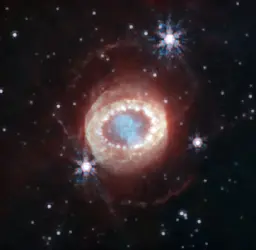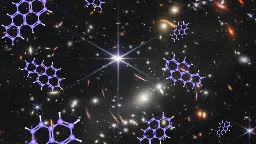
One of the brightest nebulae in the night sky is Messier 42, the Orion Nebula, located south of Orion’s belt. At its core is the young Trapezium Cluster of stars, the most massive of which illuminate the surrounding gas and dust with their intense ultraviolet radiation fields, while protostars continue to form today in the OMC-1 molecular cloud behind.
https://www.flickr.com/photos/nasawebbtelescope/53230009083/in/album-72177720305127361/

Herbig-Haro (HH) objects are luminous regions surrounding newborn stars, formed when stellar winds or jets of gas spewing from these newborn stars form shock waves colliding with nearby gas and dust at high speeds. This image of HH 211 from NASA’s James Webb Space Telescope reveals an outflow from a Class 0 protostar, an infantile analog of our Sun when it was no more than a few tens of thousands of years old and with a mass only 8% of the present-day Sun (it will eventually grow into a star like the Sun).
NASA’s James Webb Space Telescope has begun the study of one of the most renowned supernovae, SN 1987A (Supernova 1987A). Located 168,000 light-years away in

NASA’s James Webb Space Telescope has begun the study of one of the most renowned supernovae, SN 1987A (Supernova 1987A). Located 168,000 light-years away in the Large Magellanic Cloud, SN 1987A has been a target of intense observations at wavelengths ranging from gamma rays to radio for nearly 40 years, since its discovery in February of 1987. New observations by Webb’s NIRCam (Near-Infrared Camera) provide a crucial clue to our understanding of how a supernova develops over time to shape its remnant.
https://www.nasa.gov/feature/goddard/2023/webb-reveals-new-structures-within-iconic-supernova

Editor’s Note: This post highlights data from Webb science in progress, which has not yet been through the peer-review process.
NASA’s James Webb Space Telescope obtained images of the Ring Nebula, one of the best-known examples of a planetary nebula. Much like the Southern Ring Nebula, one of Webb’s first images, the Ring Nebula displays intricate structures of the final stages of a dying star. Roger Wesson from Cardiff University tells us more about this phase of a Sun-like star’s stellar lifecycle and how Webb observations have given him and his colleagues valuable insights into the formation and evolution of these objects, hinting at a key role for binary companions.
https://blogs.nasa.gov/webb/2023/08/21/webb-reveals-intricate-details-in-the-remains-of-a-dying-star/
NASA’s James Webb Space Telescope has followed up on observations by the Hubble Space Telescope of the farthest star ever detected in the very distant universe, within the first billion years after the big bang.

NASA’s James Webb Space Telescope has followed up on observations by the Hubble Space Telescope of the farthest star ever detected in the very distant universe, within the first billion years after the big bang. Webb’s NIRCam (Near-Infrared Camera) instrument reveals the star to be a massive B-type star more than twice as hot as our Sun, and about a million times more luminous.

A new image of the galaxy cluster known as “El Gordo” is revealing distant and dusty objects never seen before, and providing a bounty of fresh science. The infrared image, taken by NASA’s James Webb Space Telescope, displays a variety of unusual, distorted background galaxies that were only hinted at in previous Hubble Space Telescope images.
https://www.nasa.gov/feature/goddard/2023/webb-spotlights-gravitational-arcs-in-el-gordo-galaxy-cluster

Water is essential for life as we know it. However, scientists debate how it reached the Earth and whether the same processes could seed rocky exoplanets orbiting distant stars. New insights may come from the planetary system PDS 70, located 370 light-years away. The star hosts both an inner disk and outer disk of gas and dust, separated by a 5 billion-mile-wide (8 billion kilometer) gap, and within that gap are two known gas-giant planets.
https://www.nasa.gov/feature/goddard/2023/webb-detects-water-vapor-in-rocky-planet-forming-zone
I second Jerboa.
The James Webb Space Telescope’s four scientific instruments are capable of examining the universe across a range of light called infrared, which is beyond the red end of the visible light rainbow (Webb also captures a little visible red as well). Infrared wavelengths are broken down into near-, mid-, and far-infrared ranges. Each instrument has unique features that allow astronomers to study a variety of astronomical objects in different ways.
The discovery suggests the earliest galaxies formed more quickly after the Big Bang than previously thought.

The James Webb Space Telescope has detected the earliest-known carbon dust in a galaxy ever.
Using the powerful space telescope, a team of astronomers spotted signs of the element that forms the backbone of all life in ten different galaxies that existed as early as 1 billion years after the Big Bang.
The detection of carbon dust so soon after the Big Bang could shake up theories surrounding the chemical evolution of the universe. This is because the processes that create and disperse heavier elements like this should take longer to build up in galaxies than the age of these young galaxies at the time the James Webb Space Telescope (JWST) sees them.
https://www.space.com/james-webb-space-telescope-1st-detection-of-diamond-like-carbon-dust-earliest-stars

Using the James Webb Space Telescope (JWST), an international team of astronomers has found compelling evidence that early galaxies were responsible for the reionization of the early universe. This is the process by which neutral hydrogen atoms are ionized, making the universe transparent to light at wavelengths that would have been absorbed by the atoms. The research was done by members of the EIGER collaboration, which is using the JWST’s Near Infrared Camera (NIRCam) to study light from quasars in the early universe.
https://physicsworld.com/a/jwst-finds-smoking-gun-evidence-of-early-galaxies-transforming-the-universe/

NASA’s James Webb Space Telescope has delivered the deepest and sharpest infrared image of the distant universe so far. Webb’s First Deep Field is galaxy cluster SMACS 0723, and it is teeming with thousands of galaxies – including the faintest objects ever observed in the infrared.
https://www.nasa.gov/image-feature/goddard/2022/nasa-s-webb-delivers-deepest-infrared-image-of-universe-yet

In an enormous new image, NASA’s James Webb Space Telescope reveals never-before-seen details of galaxy group “Stephan’s Quintet”
https://www.nasa.gov/image-feature/goddard/2022/nasa-s-webb-sheds-light-on-galaxy-evolution-black-holes
This is total donkey bollocks, and you're not very good at writing a story.
A cruise line has apologized to its passengers after one of their ships arrived in the middle of a whale hunt where dozens of the animals were being slaughtered.

A cruise line has apologized to its passengers after one of their ships arrived in the middle of a whale hunt where dozens of the animals were being slaughtered.


The peculiar galaxy NGC 3256 dominates this image from the James Webb Space Telescope. This Milky Way-sized galaxy lies about 120 million light-years away in the constellation Vela, and is a denizen of the Hydra-Centaurus Supercluster.
https://www.flickr.com/photos/nasawebbtelescope/53019007937/in/album-72177720305127361/

Cheers to our first year!
Let’s celebrate one year of Webb science by taking a brand-new look at Sun-like stars being born in this detailed close-up of Rho Ophiuchi, the closest-star-forming region to Earth. Webb spotted around 50 young stars, many close in mass to our star, giving us a glimpse into the early life of the Sun. Dark, dense dust cocoons still-forming protostars, while an emerging stellar newborn (top center) shoots out two huge jets of molecular hydrogen.
https://www.flickr.com/photos/nasawebbtelescope/53040527259/in/album-72177720305127361/

Hidden in the neck of this “hourglass” of light are the very beginnings of a new star — a protostar. The clouds of dust and gas within this region are only visible in infrared light, the wavelengths that Webb specializes in.
https://www.flickr.com/photos/nasawebbtelescope/52504158265/in/album-72177720301006030/

A stunning smash-up of two spiral galaxies shines in infrared with the light of more than a trillion suns. Collectively called Arp 220, the colliding galaxies ignited a tremendous burst of star birth. Each of the combining galactic cores is encircled by a rotating, star-forming ring blasting out the glaring light that Webb captured in infrared. This brilliant light creates a prominent, spiked, starburst feature. Credits: NASA, ESA, CSA, STScI, Alyssa Pagan (STScI)
https://www.nasa.gov/feature/goddard/2023/webb-captures-the-spectacular-galactic-merger-arp-220

Webb NIRCam composite image of Jupiter from three filters – F360M (red), F212N (yellow-green), and F150W2 (cyan) – and alignment due to the planet’s rotation. Credit: NASA, ESA, CSA, Jupiter ERS Team; image processing by Judy Schmidt.
https://blogs.nasa.gov/webb/2022/08/22/webbs-jupiter-images-showcase-auroras-hazes/

Webb found complex organic molecules similar to smoke or smog in a galaxy more than 12 billion light-years from Earth.
https://www.flickr.com/photos/nasawebbtelescope/52958010034/in/album-72177720305127361/
A bellend in the UK, Bulgaria and Italy.
I'm a RIF Refugee, and I was just recommended Connect for Lemmy, and I'm using it right now. It's on the Play store.
